OCZ Petrol 128 GB Solid State Drive Review

The refreshed SSD lineup from OCZ currently includes Petrol SATA 6 Gbps SSD drive with a very appealing price tag. It is built using the same technologies as the popular Octane and Vertex 4 products. However, the question is: did they have to sacrifice all the advantages of the Indilinx Everest controller in an attempt to slash the price or this device? Let’s find out!
With its aggressive marketing strategy, interesting products and extensive dealer network, OCZ Technology has risen up to a leading position on the market of consumer-class solid state drives. It is no wonder then that we often review its SSDs on our site, especially now that OCZ has got the Indilinx development team who have come up with two high-performance solutions, the two versions of the Everest controller, in the last few months. Using these controllers, OCZ has begun to produce unique SSDs that form a complete product range now. The company currently offers three SSD series: the high-performance Vertex 4, the mainstream Octane and the entry-level Petrol. We’ve covered the first two in our reviews already, so it’s time for us to take a look at the Petrol as well.
As a matter of fact, the OCZ Petrol was announced quite a long time ago, at the end of the last year, but we haven’t been able to get a sample to test. The manufacturer was uncooperative and, considering the scarcity of reviews of that model on the Web, seems to keep the Petrol from mass media. Perhaps people at OCZ think that such entry-level products can find their way to the customer on their own, by means of the attractive price tag only. Or maybe their marketing department fears that publishing benchmark results for a slow entry-level SSD is going to harm the company’s reputation. On the other hand, this secrecy raises apprehensions about Petrol’s competitiveness in comparison with other entry-level SSDs, especially as we can indeed find negative user reports about the Petrol’s reliability and speed on web forums.
Whatever the reasons, the Petrol has found itself in a kind of informational vacuum, and we want to correct this now. You might be interested because the Petrol is one of the cheapest 6Gbit/s SSDs available in terms of the cost per gigabyte of storage.
Closer Look at OCZ Petrol 128 GB
So, what is the Petrol made of? Also based on Indilinx hardware, the midrange Octane and the high-end Vertex 4 employ flash memory with synchronous interface, so it is quite natural for the Petrol to be not only based on the junior version of the Everest controller but also have cheaper asynchronous flash. The result looks like a simplified Octane. The Petrol can’t be fast with such memory inside, but its price is highly attractive.
The Petrol doesn’t come in too many variants. It is only available in capacities of 64 GB and 128 GB. The lack of larger capacities could be expected but some users would certainly find a use for a storage capacity in between these two. We’ve got the larger variant for our tests, so let’s take a closer look at it.
The OCZ Petrol 128 GB is shipped in a standard plastic blister wrap. The lack of accessories is not surprising considering the manufacturer’s desire to make this product as cheap as possible. A user manual and a small promo sticker are the only things you can find in this package besides the SSD.
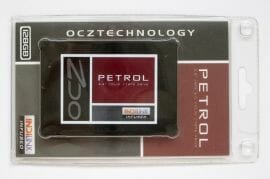
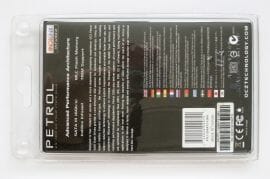
The Petrol features OCZ’s traditional SSD case with a metallic bottom and a soft plastic top. There’s a label with the series name on the latter. As you can see, brown is the distinguishing color of the Petrol series. The back of the case has a more informative label which at least tells you the storage capacity of the SSD.
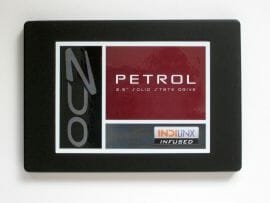
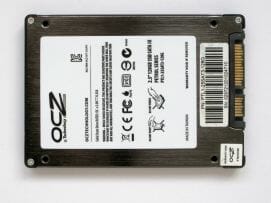
The Petrol’s PCB resembles the Octane’s in some respects, which might be expected since both use the same first-generation Indilinx Everest controller. Besides the controller chip, the PCB carries 16 BGA-packaged chips of asynchronous flash memory manufactured by SK Hynix. Each contains one 64-gigabit 26 nm NAND die.
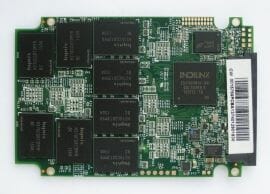
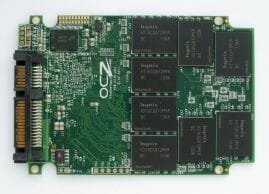
This kind of flash memory is but rarely installed in SSDs. Being slow, it is mostly limited to smartphones, tablet PCs and USB flash drives, but OCZ thinks it a reasonable compromise between performance and price, especially as the Everest controller works in 8-channel mode with 2-way interleave to make up for the low bandwidth of the memory chips’ interface. Another factor that should help accelerate the Petrol 128 GB is its cache memory represented by two 256 MB DDR3-1600 SDRAM chips from Micron.
Here is a summary of the Petrol 128 GB specs:
- Controller: Indilinx Everest;
- Interface: SATA 6 Gbps;
- Flash-memory: asynchronous 26 nm NAND;
- Size: 128 GB;
- Cache-memory: 512 MB DDR3-1600 SDRAM;
- Sequential read speed: 360 MB/s;
- Sequential write speed: 180 MB/s;
- Random read speed (4 KB blocks): 32000 IOPS;
- Random write speed (4 KB blocks): 14500 IOPS.
Even the official numbers declared by OCZ look downright poor compared to inexpensive SandForce-based SSDs with asynchronous flash. And the 64 GB Petrol is even slower!
Well, the Petrol has one indisputable advantage over its SandForce-based counterparts. The reserved pool of memory cells that’s used in garbage collection operations and to replace failed cells is 7 rather than 13% of its total capacity. Therefore, when formatted, the Petrol 128 GB offers the user as much as 119 gibibytes of storage.
OCZ provides its Toolbox utility for managing any Everest 1/2-based SSD. It helps you update firmware, view S.M.A.R.T. parameters and perform a Secure Erase command.
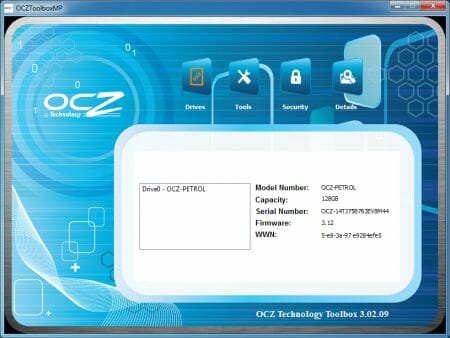
By the way, the S.M.A.R.T. parameters of our sample changed alarmingly during our test session, indicating that the SSD’s flash memory had begun to wear off.
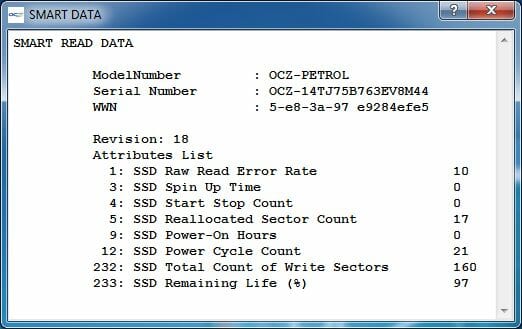
It’s the first time we see an SSD wear off that rapidly. Our tests do not usually affect SSDs as much as to cause reallocated sectors. We may have been unlucky to get a poor sample of the SSD, but we can also suspect that the entry-level Petrol just uses low-grade flash memory.
The current firmware for the Petrol series is version 1.3. It has already improved performance compared to the earlier versions, so we can hardly expect this series to change dramatically with future firmware updates.
Testbed Configuration
For our today’s SSD test session we put together a system on an Intel H67 based mainboard. This chipset provides support for two SATA 6 Gbit/s ports, which we use to connect the tested SSDs.
We are going to compare OCZ Petrol 128 GB against a few different SSDs with different storage capacity based on SF-2281 controller. They are a typical SSD with 25 nm synchronous ONFI memory (Corsair Force Series GT – analogue to OCZ Vertex 3) and a typical SSD with 25 nm asynchronous memory (Corsair Force Series 3 – analogue to OCZ Agility 3). Moreover, we also included the recently tested Kingston SSDNow V+200 120 GB SSD, which, just like Corsair Force Series 3, is also based on SandForce SF-2281 controller and uses asynchronous memory.
Overall our testbed was configured as follows:
- Intel Core i5-2400 (Sandy Bridge, 4 cores, 3.1 GHz, EIST and Turbo Boost turned off);
- Foxconn H67S mainboard (BIOS A41F1P03);
- 2 x 2 GB DDR3-1333 SDRAM DIMM 9-9-9-24-1T;
- Crucial m4 256 GB system disk (CT256M4SSD2);
- Tested SSDs:
- Corsair Force 3 Series 120 GB (CSSD-F120GB3-BK, firmware version 1.3.3);
- Corsair Force GT Series 120 GB (CSSD-F120GBGT-BK, firmware version 1.3.3);
- Kingston SSDNow V+200 120 GB (SVP200S3/120G, firmware version 501);
- OCZ Petrol 128 GB (PTL1-25SAT3-128G, firmware version 1.3).
- Microsoft Windows 7 SP1 Ultimate x64
- Drivers:
- Intel Chipset Driver 9.3.0.1019;
- Intel Graphics Media Accelerator Driver 15.22.54.2622;
- Intel Rapid Storage Technology 11.1.0.1006.
Performance
Random and Sequential Read/Write
We use CrystalDiskMark 3.0.1 benchmark to test the random- and sequential read and write speed. This benchmark is convenient to work with as it can measure the speed of an SSD with both incompressible random and fully compressible recurring data. This feature is important for testing SSDs based on SF-2281/2282 controller, which tries to compress the data before writing it into memory. So, there are two numbers in the diagrams below that reflect the maximum and minimum SSD speed. The real-life performance of an SSD is going to be in-between those two numbers depending on how effective the controller data compression is.
Note that the performance tests in this section refer to SSDs in their “Fresh Out-of-Box” state (FOB). No degradation could have taken place yet.
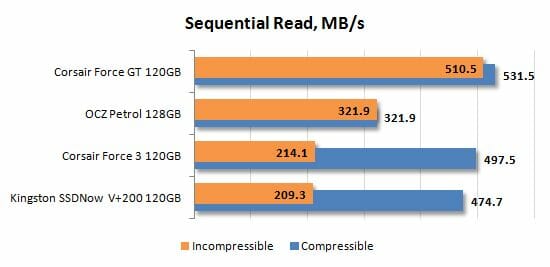
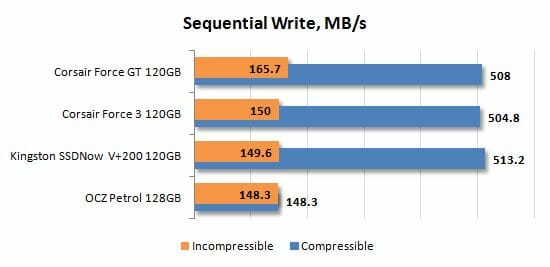
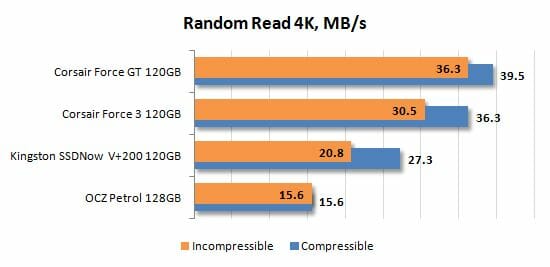
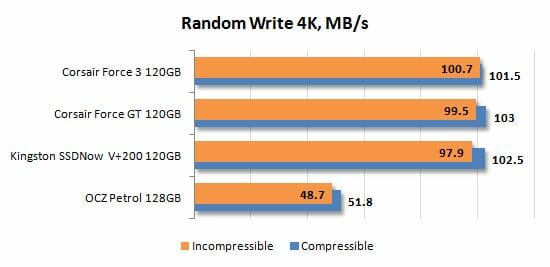
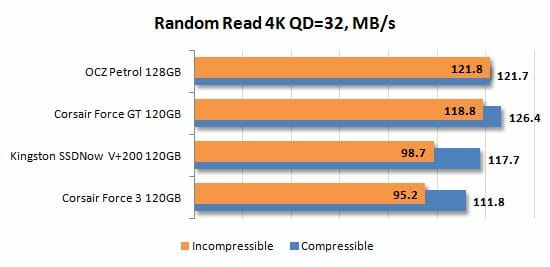
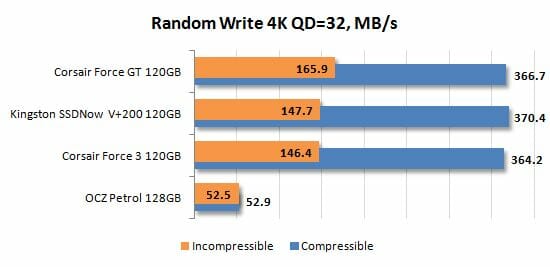
The OCZ Petrol is unexpectedly good at sequential operations. It is even ahead of both SandForce-based SSDs with asynchronous flash at reading and only falls behind the expensive Corsair Force Series GT which features synchronous flash with ONFI interface. On the other hand, processing 4 KB data blocks, a popular operation in real-life applications, reveals a weak spot of the Petrol. A long request queue may help at reading, but desktop applications do not usually produce it. Thus, the OCZ Petrol doesn’t seem to be fast even by the standards of inexpensive SSDs.
By the way, the Petrol’s Everest controller differs from the SandForce not only in speed specs but also in not compressing data when writing into flash memory. This means that the Petrol will deliver the same performance, predictable and repeatable, irrespective of data type.
Degradation and Steady-State Performance
Unfortunately, SSDs are not always as fast as in their “fresh” state. In most cases their performance goes down after some time and in real life we deal with completely different write speeds than what we see on the diagrams in the previous chapter of our review. The reason for this phenomenon is the following: as the SSD runs out of free pages in the flash memory, its controller has to clear memory page blocks before saving data into them, which causes substantial delays. Although, modern SSD controllers can alleviate the performance drop by erasing unused flash memory pages ahead of time, when idle. They use two techniques for that: idle-time garbage collection and TRIM.
Of course, users are more interested in the consistent performance of their SSDs over a long period of time rather than the peak speed they are going to see only during the initial short-term usage period, while the drive is still “fresh”. The SSD makers, however, declare the speed characteristics of “fresh” SSDs for marketing reasons. That’s why we decided to test the performance hit that occurs when a “fresh” SSD becomes a “steady” one.
To get a complete picture of SSD performance degradation we ran special tests based on the SNIA SSSI TWG PTS (Solid State Storage Performance Test Specification) methodology. The main idea of this approach is to measure write speed consecutively in four different cases. First we measure the “fresh” SSD speed. Then we measure the speed after the SSD has been fully filled with data twice. The third test occurs after a 30-minute break during which the controller can partially restore performance by running the idle-time garbage collection. And finally, we measure the speed after issuing a TRIM command.
We ran the tests in synthetic IOMeter 1.1.0 RC1 benchmark, where we measured random write speed when working with 4 KB data blocks aligned to flash memory pages at 32 requests queue depth. The test data were pseudo-random.
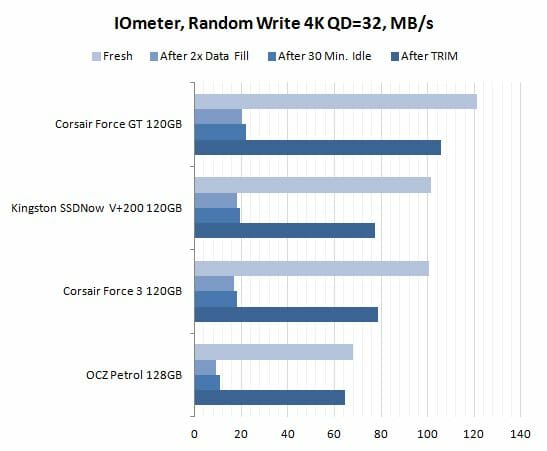
As we’ve noted in our earlier reviews, SSDs with second-generation SandForce controllers are more susceptible to performance degradation than, for example, SSDs with Marvell or Indilinx controllers. The OCZ Petrol doesn’t offer anything new in this respect. Its performance lowers by a factor of 8 as it gets filled up by data. Its own garbage collection doesn’t help much, but the TRIM command restores the Petrol back to its original speed. The TRIM implementation in the Indilinx Everest controller is almost perfect: any SSD based on that hardware platform can be restored back to its original performance. We mean this Petrol as well as the Octane and Vertex 4 SSDs we covered in our previous reviews.
The efficient TRIM can improve our opinion about the Petrol’s speed because its SandForce-based opponents can never be restored to their out-of-box state. The write speed tests in the previous section of our review reflect the out-of-box performance and you can see the SSDs’ write speed degradation in the next diagram, as measured with CrystalDiskMark 3.0.1.
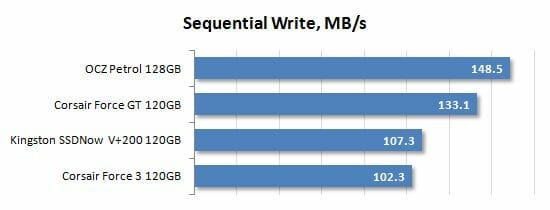
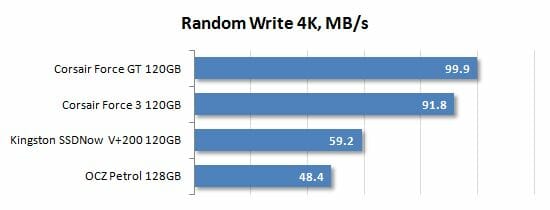
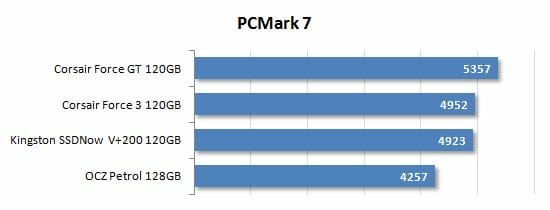
We’ve got a different picture with sequential writing now. The steady-state Petrol is unexpectedly ahead of all of its opponents with second-generation SandForce controllers. On the other hand, it is so slow with small chunks of data that even its perfect TRIM implementation can’t save the day.
Generally speaking, the Petrol’s behavior reminds us of the Octane. Sharing the same Everest controller, they have the same highs and lows. The difference is that the Octane is overall faster than the Petrol, running on NAND flash memory with synchronous interface.
Futuremark PCMark7
The popular PCMark 7 contains an individual disk subsystem benchmark. It is not a synthetic test, but is based on real-life applications. This benchmark reproduces typical disk usage scenarios and measures how fast they are completed in popular applications. Moreover, the disk access commands are not executed as a steady uninterrupted flow, but in a more realistic manner – with certain pauses caused by the need to process the data. The benchmark generates an overall disk subsystem performance rating as well as speed readings in MB/s in individual usage scenarios. Note that the absolute speed in these scenarios is not too high because of the above mentioned pauses between individual input/output operations. In other words, PCMark 7 shows you the speed of the disk subsystem from the application’s point of view. Numbers like that show us not only the pure performance of an SSD, but mostly how big of a performance gain a certain SSD can guarantee in real life.
We ran PCMark 7 on “steady” SSDs, which is what they are going to be in actual computer systems most of the time. Their performance in this case is affected not only by their controller or flash memory speed but also by the efficiency of their internal algorithms that fight performance degradation.
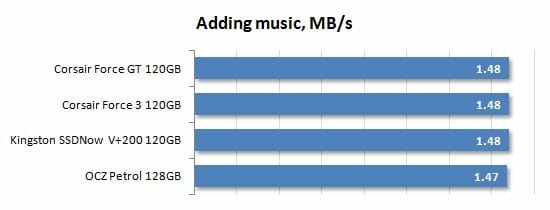
The PCMark 7 score is a good guide for people who don’t want to delve into technicalities but need a simple illustration of relative performance of SSDs in typical desktop applications. As if summing up all the weak points of the Petrol, PCMark 7 puts it in last place, more than 15% behind the SandForce-based SSDs. This benchmark doesn’t seem to be impressed at all by the Petrol’s advantages, such as its good speed at sequential operations with incompressible data.
Now let’s check out the individual tests to get a more detailed picture of what our SSDs are capable of under various types of operational load:
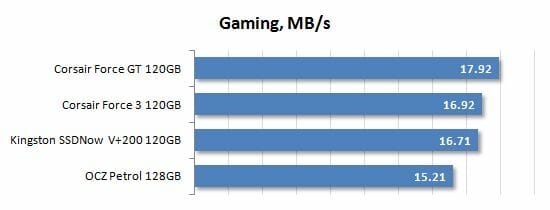
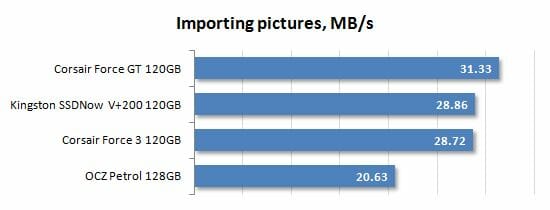
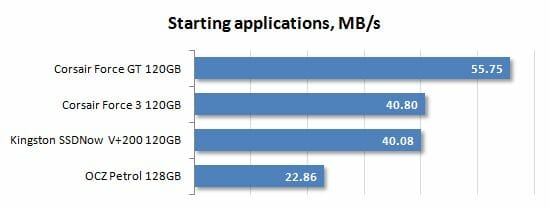
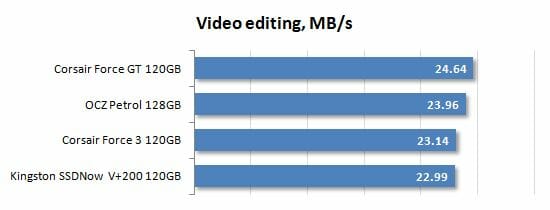
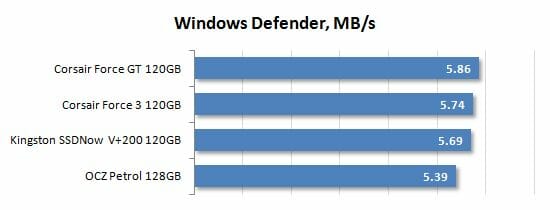
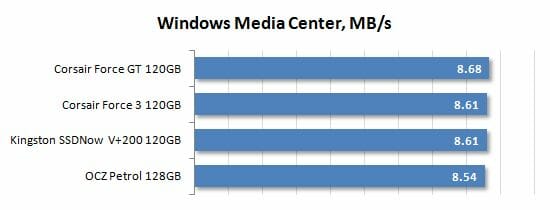
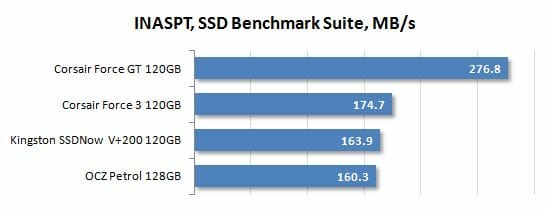
The Petrol is competitive in usages scenarios involving multimedia content. It’s no wonder since video and audio files are typically large and cannot be compressed. The Petrol’s performance in the other scenarios is rather poor.
Intel NAS Performance Toolkit
Intel NASPT is another disk sub-system test that uses real-life usage scenarios. Like PCMark 7, Intel NASPT reproduces predefined disk activity traces and measures how fast they are executed. However, the default traces are designed for network attached storage devices rather than for SSDs. Therefore during our test session we replace them with the specially developed SSD Benchmarking Suite which offers more relevant usage scenarios such as compressing and decompressing files, compiling large projects, copying files and folders, loading 3D game levels, installing software, batch-processing photos, searching a digital library for data, mass-launching applications, and transcoding video.
Like PCMark 7, this benchmark gives us a true-to-life illustration of disk subsystem performance. Here the SSDs are again tested in their “steady” state.
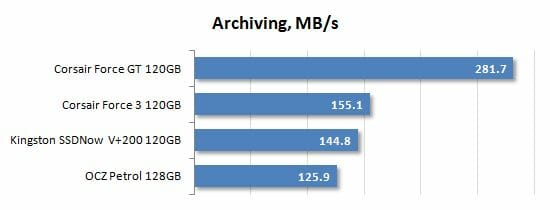
Intel NASPT is not so pessimistic about the Petrol. Yes, the latter takes last place in the diagram, but it is not much different from the Kingston SSDNow V+200 which we found in our previous review to be the slowest among SandForce-based SSDs with asynchronous memory.
The detailed INASPT results help us see what usage scenarios are the most suitable for our today’s testing participants. Take note that the data-transfer rate is higher than the SATA III interface bandwidth in some subtests. That’s because INASPT is a high-level test that uses standard Windows functions to access the disk subsystem. As a result, the OS caching mechanisms also affect the results.
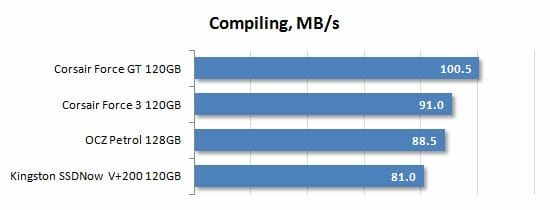
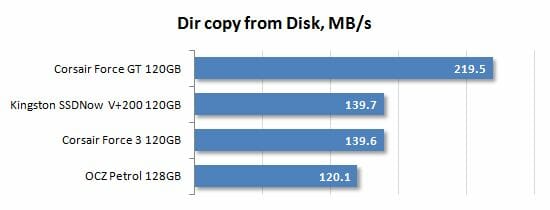
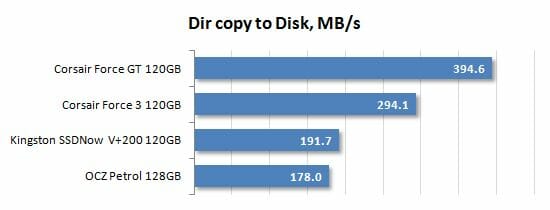
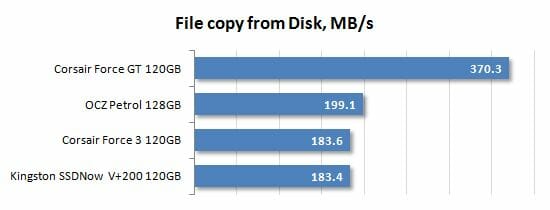
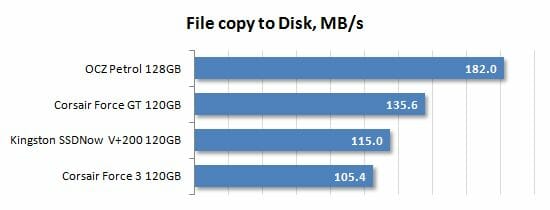
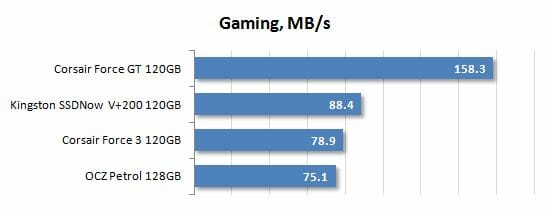
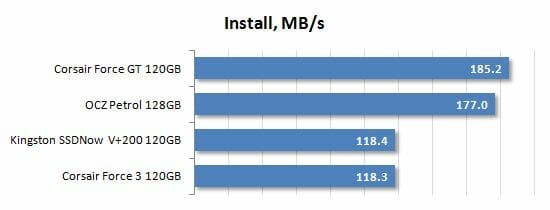
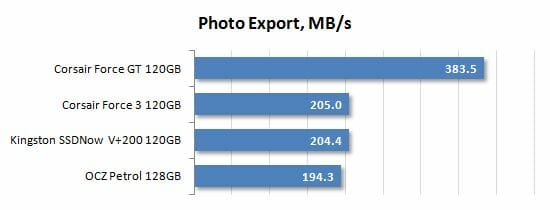
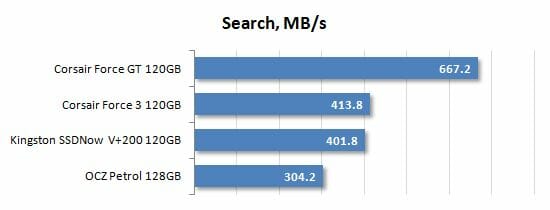
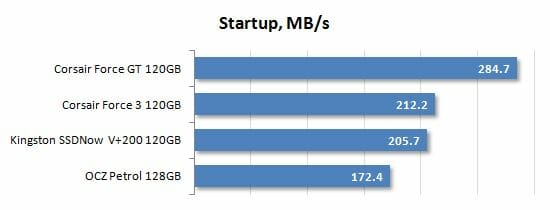
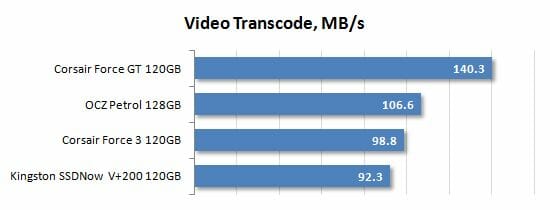
It is easy to discern a pattern in the Petrol’s behavior. This SSD is lackluster when processing a lot of small files, but accelerates on large files. Thus, it is inferior to SandForce-based SSDs with asynchronous flash in such tasks as archiving, folder management, games, photo management, data search, and launching of the OS and applications. On the other hand, the Petrol is fast at copying large files, installing software and working with videos, and even occasionally outperforms the Corsair Force GT Series that is equipped with synchronous NAND flash.
File Copying Speed
We use AS SSD version 1.6.4237.30508 to benchmark the speed of copying files within a single partition the size of the whole SSD. The SSDs are tested in their steady state.
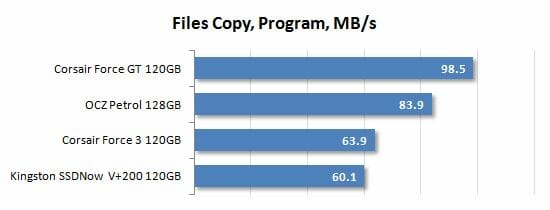
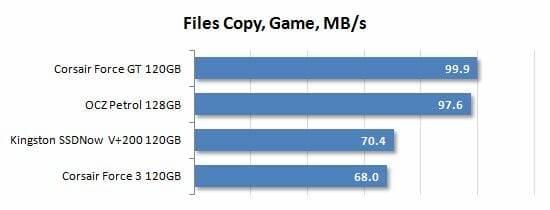
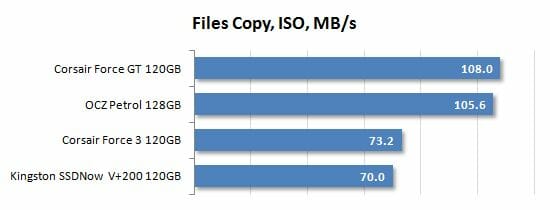
The Petrol is expectedly fast in the AS SSD file copy test. It is in between the SandForce-based SSDs with synchronous and asynchronous memory.
Conclusion
The various kinds of OCZ’s newest SSDs based on Indilinx platforms are similar in many ways. The Vertex 4, Octane and Petrol are not leaders in their respective classes but each of these Everest/Everest 2 based products has some interesting peculiarities. The OCZ Petrol, for example, is fast at sequential operations and thus can quickly process large files. It also offers consistent behavior which does not depend on the type and the degree of compressibility of data.
However, positioned as an entry-level product, the Petrol will hardly be chosen for high performance in specific usage scenarios. It would be much more attractive if it had no performance hits when working under specific types of load. Unfortunately, Petrol cannot offer continuous consistency under all types of operational load. As our tests have shown, the Petrol is seriously slower than inexpensive SandForce-based SSDs in many typical applications. Therefore, Petrol may be not the best choice when it comes to inexpensive entry-level SSDs.
On the other hand, we wouldn’t dismiss the Petrol completely. Its extremely low price is an indisputable advantage over SandForce-based SSDs with asynchronous flash. It is in fact one of the cheapest SSDs with SATA III interface available now, which is its main selling point. After all, the Petrol will be way faster than any conventional HDD and many users just wouldn’t ask for more anyway.